Euphorbia (Euphorbia) - description of varieties
In modern gardening, euphorbia (euphorbia) is valued for its unpretentiousness and high decorativeness. This crop is grown everywhere. Consider what species exist and how to care for them.
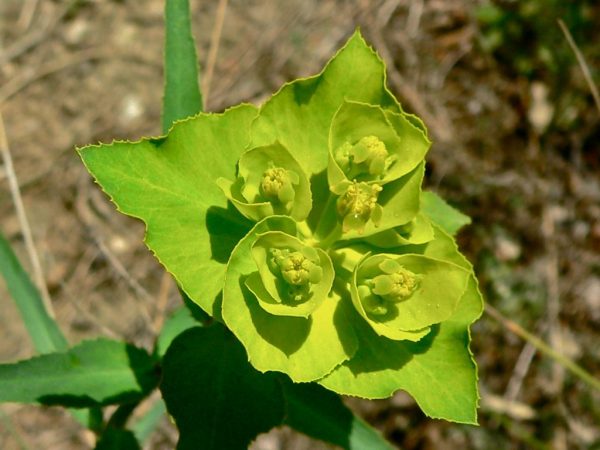
Euphorbia health benefits and harms
General characteristics of the plant
Euphorbia is a genus of herbaceous plants belonging to the Euphorbia family. The Latin name is Euphorbia.
The homeland of growth is the Madagascar and Mexican dry regions.
External features:
- has massive shoots;
- leaves are oval, with pointed tips, of different colors - green, emerald, with a reddish, bluish or purple tint, depending on the subspecies;
- the root system is superficial fibrous, tuberous or pivotal;
- blooms in small or medium inflorescences, there are plants with red, yellow, purple, pink or snow-white buds.
Almost all types of euphorbia, when fractured, secrete milky juice, which is considered poisonous. When in contact with the skin, it causes an allergic reaction - redness, irritation.
Purchase rules
You can buy cultivated species of milkweed for cultivation on a personal plot or at home in any gardening store.
When buying a flower, you should carefully examine the crown - it is important that there are no signs of infection with diseases and mechanical injuries on it. If, when shaking off, the leaves do not crumble, then the plant is fresh.
After the purchase, indoor specimens need to be given time to adapt - they are placed in a three-week quarantine in a separate room.
Conditions of detention
Growing requires a loose, well-drained substrate with neutral acidity. You can also take a ready-made soil mixture intended for planting cacti and succulents. You can also prepare it yourself - mix turf, leafy soil, peat, brick chips and coarse sand in a ratio of 2: 2: 2: 1: 1.
This plant needs intense light throughout the year. It is placed on the southern, southwestern, or southeastern windowsill. They shade in the sun to prevent burning of the stems and leaves.
In spring and summer, the optimal mode of keeping in an apartment is 20-25 ° C. With the arrival of winter, the plant goes into a dormant phase, so it needs coolness - it is kept at a temperature of 15-16 ° C.
Easily tolerates a sharp rise or fall, but does not like drafts. At the time of airing the room, he is taken out to another room.
Overview of varieties
Wild
There are several species of milkweed that grow successfully in the wild, occupying large areas.
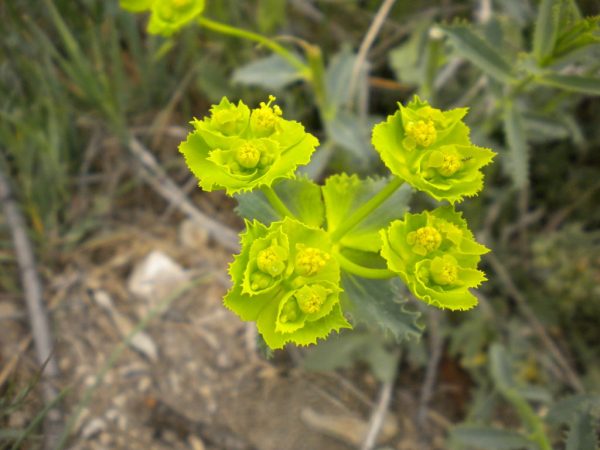
Euphorbia photo weed with thorny leaves
- Swamp. Perennial plant 50 cm high with erect stems and oblong green leaves. Umbrella-shaped inflorescences.Distributed in desert and steppe areas.
- Weed (weed). An annual with a succulent stem, compact size - about 20 cm high. Inflorescences bloom in summer, look in the form of red bells.
- Steppe. Homeland habitat - the coast of the Volga, Don, also found on the Caucasian slopes. A perennial crop with an upright stem. It can bloom in small white or yellow inflorescences throughout the summer.
- Sharp (field or meadow). Prefers to grow along rivers, covers large areas in pastures, meadows, fields and forests. They can feed chickens, pigs, chickens, turkey poults, goslings.
Garden
In a cultivated form, gardeners use several species of euphorbia with different life cycles.
1. Annuals.
- Bordered (mountain snow). In nature, it occurs on mountain tops and rocky slopes. A very beautiful plant in the flowering phase forms a lush white crown - light green leaves are covered with snow-white stripes. They are decorated with white bracts. It blooms in early summer and fades in late autumn.
- Variegated. Decorative-deciduous type with rich green foliage, erect stems. The flowers are composed of red, white or variegated petals. The height of the shoots is about 1 m.
2. Perennial plants please with decorativeness for several years in a row and have good winter hardiness. They are often grown for cutting, because they stand in a bouquet for a long time.
- Cypress. The height of the bush is 0.5 m. The leaves are thin, needle-shaped, green. The flowers are small, beige, red or yellow.
- Fiery (Griffith). It grows quickly, so it takes up a lot of space in the garden. The leaves are green, with the arrival of autumn they acquire a reddish-red color. The flowers are small, reddish or orange in color.
- Fisher (Pallas, root man or grass man). A compact plant with a height of 20-60 cm with erect pubescent stems, densely covered with long and narrow leaves of a light green shade with a grayish tint. Prized for its colorful bloom that starts in May and ends in July. Small lemon-toned flowers, collected in umbrella-shaped inflorescences.
- Rod-shaped (vine). Single-stem plant, shoot height - 50-60 cm. Along its entire length, covered with narrow leaves of a silvery-green tone. At the top, inflorescences are formed from small yellowish buds with a diameter of 1 cm.
- Poisson. A beautiful, lush shrub that has decorative green foliage with elements of beige or white. The plant does not bloom, but due to the variegation of leaves, it is very popular in landscape design. It is planted in a flowerbed, in mixborders, rock gardens.
Room
Perennial indoor species are valued not only for decorative flowering, but also for beautiful foliage, which pleases with monochromatic or variegated colors all year round.

Euphorbia common photo
- Medusa head. An unusual succulent with a short and thickened stem, with age it grows overgrown with numerous lateral shoots that develop in different directions. It is grown in hanging flowerpots and pots - green tentacle branches hang down beautifully, creating the effect of a curly head.
- Variegated. One of the most common African succulents, which is also found in the wild in America, as well as on the island of Madagascar. In nature, it reaches gigantic sizes - up to 10 m, in a cultivated form - up to 2 m. Fleshy stems, consist of 5 ribs. The shoots are 5-7 cm thick. Short thorns (3-4 mm long) develop on the edges.
- Bristled. A plant with a well-branched crown. Stems develop in an upright position, abundantly covered with rudimentary leaves of a rich green color.
- Triangular (triangular). This species with a bizarre shape has massive, well-branched, triangular stems. The edges of the ribs are prickly - thorns of a grayish or yellow-brown tone.
- Big-horned. Develops triangular stems with small foliage at the top, which crumbles with age.The height of the shoots is 40-50 cm. The homeland of growth is Mexico and Australia.
- Tirucalli (finger). A succulent plant consisting of numerous finger shoots. There are no thorns and leaves on their surface. With good care at home, it can bloom magnificently with small yellowish flowers.
- Canary. The scientific name is euphorbia canariensis. This is a large euphorbia in the form of a bush or tree, in natural conditions it reaches 12 m in height. In cultivated form - 1-2 m. Stems are massive, four or pentahedral. The ribs contain small tubercles. The diameter of the shoots is 5-6 cm. Leaves of a rudimentary type develop under each bulge. The stems are covered with thorns about 0.5 cm in length.
- White-veined. The plant is recognized by its unusual leaves - they are green, contain clearly pronounced transverse white veins.
- Mile (brilliant). The ornamental plant is popularly called the crown of thorns. Forms a dense crown with lush branching. At the top of the stems, beautiful flowers bloom in red or scarlet. Shoots are covered with thorns.
- Poinsettia. Other names are Euphorbia, the most beautiful, Christmas star. It is bought on the eve of Catholic Christmas. A flower with bright red stipules, forming large inflorescences at the top of the shoots, decorates any interior. This plant is annual, it can bloom in December.
- Fat. The plant is in the form of a cactus, 30 cm high and 10 cm in circumference. The stem is ribbed, divided into several weakly expressed edges. On each buds are formed, over time, leaves.
- Laktea. A beautiful plant with emerald foliage and colorful blooms that, with good care, lasts throughout the year.
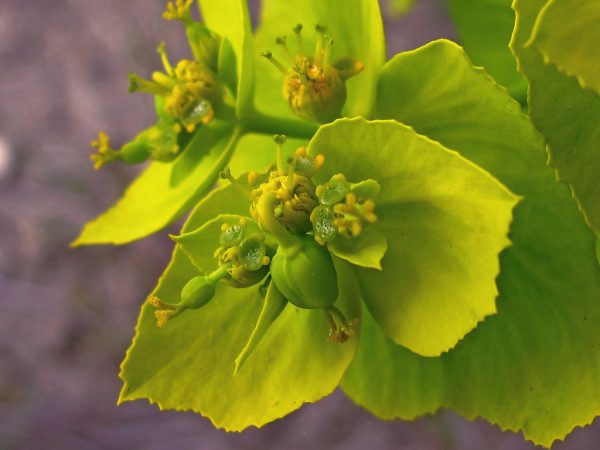
How to make euphorbia bloom
- Diamond frost. The crown resembles a cap, consisting of thin emerald stems covered with small white flowers.
- Ordinary (ordinary). This species has a compact crown - erect stems, medium foliage. The leaves are green, oval with pointed tips. It blooms with small yellow or white buds, collected in umbrella inflorescences.
- Mirsinites is a climber. Plant with erect stems covered with long dark green leaves. The flowering is inconspicuous - the buds are small, pale yellow or white. It is appreciated for the decorativeness of the leaves that do not crumble all year round.
- Volus-leaved (hare ears, in Latin - bupleurifolia). This is a perennial succulent with lanceolate-spatulate leaves, 5-7x3 cm in size and a thick short stem 20 cm high, with a circumference of 7 cm. The surface of the shoot is covered with brown, hard scales. The leaves develop at the apex, forming a not dense rosette. In appearance, it resembles prostrate euphorbia. In the winter season, the foliage falls off.
- Almond purpurea. The botanical name is euphorbia amygdaloides purpurea. One of the most decorative varieties with dark purple, erect stems, densely covered with narrow leaves (length 8-10 cm, width 1 cm). The color of the leaf plate is emerald with a burgundy tint. Height - from 40 to 60 cm. At the top of each stem, several small inflorescences are formed, consisting of light green or light green, rounded petals.
- Comb-ribbed. Medium height - up to 50 cm, forms tiny white flowers, framed by red or pink bracts. The stems are in the form of ridges - tetrahedral.
Landing
For planting, a not too deep, but wide capacity is used, since almost all species have a branched superficial root system.
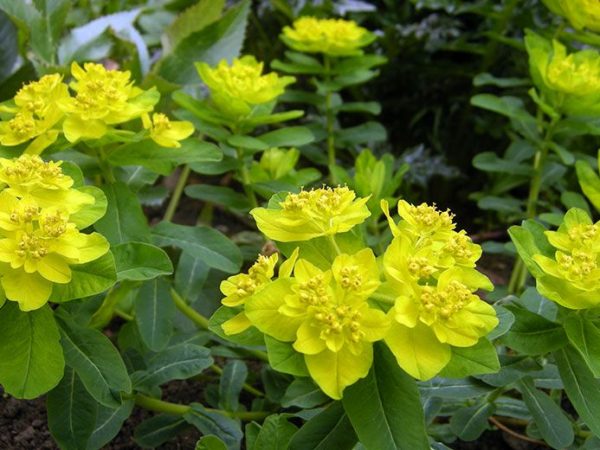
Why did the spurge suddenly turn yellow
A pot made of ceramic, clay or plastic with drainage holes in the bottom is suitable.
Technology:
- Expanded clay and fertile soil are covered.
- The roots are lowered, sprinkled with earth to the top, tamped, watered with water at room temperature.
- A support is installed so that the plant takes an upright position.
Care features
In order to achieve maximum decorative effect from milkweed, it is necessary to ensure proper conditions of detention.
Watering
Water it abundantly, but only after the soil dries to a depth of 4-5 cm. If it is a cactus plant, watering should be scarce, since moisture deficiency is replenished due to fleshy and juicy stems.
In winter, watering is extremely rare - no more than once a month to avoid waterlogging and decay of the root system.
Top dressing
To increase immunity and to make it bloom, you can feed the euphorbia with a mineral composition for cacti and succulents.
Fertilizer is applied once a week, observing the dosage indicated on the package. After that, abundant watering is carried out so that the roots absorb nutrients faster. In winter, in the resting phase, they do not feed.
Pruning
Euphorbia white-necked and ribbed, cactus varieties do not need pruning. You can pinch all the rest so that they bush well.
The pinching is done on the apical shoots - the stems are carefully separated by 2-3 cm in length. This will stimulate the development of new processes.
Additionally, during the entire growing season, diseased stems and leaves are pruned. For shaping and sanitary haircuts, a sterile and well-sharpened tool is taken to avoid excessive injury and infection.
Transplant rules
Purchased flowers are necessarily transplanted, since the store substrate does not contain nutrients for growth and flowering.
- Take a container 2-3 cm larger in diameter of the old flowerpot.
- Drainage is placed on the bottom, half filled with a nutrient composition. Water the flower, remove it and, together with an earthen clod, transfer it into a new pot.
- If necessary, the soil is poured to the top and moistened.
The frequency of transplantation of domestic milkweed depends on age: young - after a year, adults - every 5 years.
If the plant has rotted roots, it also needs to be transplanted, otherwise it will die.
- The flower is removed from the flowerpot, washed from the ground, cut out the rot to healthy tissue, dipped in a fungicide solution for an hour.
- Then they are dried, the places of the cuts are sprinkled with charcoal, planted in a new container with sterile soil mixture.
Reproduction methods
Children
This method is suitable for cactus euphorbia. Separate the baby along with the resulting roots with a sharp knife. They are treated with Kornevin's solution so that it takes root faster.
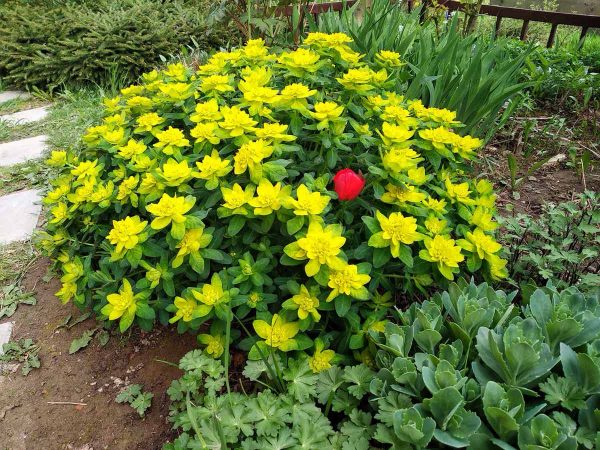
How to transplant spurge in the country
They are planted in a nutritious substrate for succulents and cacti. A varietal plant can be grown from such a shoot.
Cuttings
Method for plants with good branching. At the top, several shoots with leaves and buds are selected, cut off.
The optimum length of the cuttings is 15-20 cm. In the lower part, all the leaves are cut off, dipped in water for a couple of hours to drain the milky juice, then dried.
They are planted when a thin film appears on the sections. It can be rooted in a light and loose substrate of peat and sand. The seedlings are watered with warm water, covered with a transparent cap, placed in a warm and well-lit place. Ventilate daily, moisturize if necessary.
After about 2-3 weeks, each sprout will begin to develop leaves, then the shelter is removed. They grow for another month so that the seedlings are overgrown with roots, then they are planted separately.
This method of reproduction makes it possible to obtain new specimens with all the varietal characteristics of the mother plant.
Euphorbia propagates by seeds in the wild; in private floriculture, this method is rarely practiced, since seeds have poor germination. At home, it is problematic to create the necessary conditions for seed germination.
Diseases and pests
Euphorbia contains milky juice, which releases toxins, so it is rarely damaged by insects and infections. Infection and loss of decorativeness is possible if the plant is not taken care of.
| Diseases and pests | Diagnostics | Treatment | Prophylaxis |
| Root rot | Appears in plants that are often poured with cold water. Fungal infection affects the roots, then spreads to the stems - they darken, become covered with bloom, soften and die off | The flower is removed from the flowerpot, if the root has completely rotted, disposed of. Before that, a couple of stems are cut for rooting. The plant, which is partially damaged, is washed from the soil, all the rot is cut out, and immersed in a fungicide solution for an hour. Dried, planted in a new pot with a sterile substrate | Adjust watering. Use room temperature water for humidification |
| Powdery mildew | Shoots and leaves are covered with a whitish powdery bloom. Over time, the affected areas turn black, rot and die off | The control measures are as follows - they cut out all the places that have wilted and acquired an unnatural color. You can get rid of the sore by treating the crown with fungicides - Ridomil Gold, Skor, Topaz or Hom | Provide the required level of humidity, avoid overflows, regularly remove yellowed, dried out and decayed organs |
| Bacteriosis | Oppresses the growth, flowering of the plant. Leaves and stems are covered with weeping spots that give off an unpleasant odor | It is not possible to save such a flower, since it cannot be treated | Observe the rules of care, maintenance, avoid mechanical damage |
| Mosaic | The leaves are covered with a speckled pattern of red, yellow or white spots. Chlorosis later appears. Foliage turns yellow, deformed | Insecticide treatment - Fitoverm, Topaz, Aktara | Purchase of healthy plants spraying with pesticides in spring and autumn |
| Alternaria | Fungal infection that manifests as dense brown growths on the surface of leaves and stems | Sore areas are cut out, treated with Skor, Bordeaux liquid or Ridomil gold | Buy healthy flowers, use sterile soil for planting and transplanting |
| Mealybug | Leaves a whitish bloom on the surface of the leaf plate, over time it darkens. The affected areas dry out and die off. Such spurge drops foliage en masse. | Collect all the leaves that have fallen, cut off the sick ones. You can destroy insects with Dichlorvos, Karbofos | Application of fresh and disinfected soil for cultivation |
| Shield | Brown or red plaque-shaped growths stick to the surface of stems and leaves. They suck the juices out of them. In places of parasitism, tissues turn black and die | Cutting out all damaged parts, treatment with Actellic or Fosbicid twice with an interval of 7 days | In order not to have to fight this parasite, it is necessary to observe all the rules of care, to cut off non-viable organs in a timely manner. Buy healthy plants, quarantine |
| Aphid | Light green beetles settle in colonies on the underside of the leaves. They feed on their juice, which leads to curling, drying out and falling off | Euphorbia, which has turned yellow and dry, must be freed from spoiled parts. Then carry out the treatment with Fitoverm or Aktellik | Timely removal of rotten and yellowed leaf shoots. Buying healthy flowers |
Signs and superstitions
There are several popular beliefs about this flower:
- Indoor euphorbia brings harmony to the house and improves mood.
- A great benefit of a flowering plant is its ability to attract happiness and serenity.
- It needs to be kept in the apartment by emotional people. It soothes, relieves tension and helps to cope with stressful situations more easily.
- Belozhilkovy infects with good energy - protects against damage, evil eye, evil thoughts of ill-wishers.
- According to Feng Shui, the view with thorns should not be kept in the bedroom or children's room. It has negative magical properties and attracts discord, illness, and unhappiness for all family members.
Can I eat
Milky juice contains toxins that can cause severe poisoning not only in children, pets, but also in adults. Therefore, in order not to get poisoned, eating stems and leaves is contraindicated. It is also possible that allergies appear on the face, skin of the hands when milk gets in. When leaving, wear rubber gloves and a mask to protect the eyes.

Euphorbia annual pinching and growing from seeds
Among all the varieties, only one species has unique healing properties - the Pallas spurge. It is widely used in folk medicine. The plant contains a large amount of useful minerals, acids, vitamins. It is a powerful immunostimulant, the healing qualities of which are manifested in the ability to eliminate many ailments:
- ovarian disease in women;
- the prostate gland in men;
- infertility, mastopathy, myoma;
- sexually transmitted infections;
- an excellent antifungal agent that well treats warts, abscesses, scabies, boils, burns and abscesses;
- effective in the prevention of cancer.
Leaves and stems are used for the preparation of alcoholic tinctures, decoctions. Fresh milky juice is poisonous, so before drinking a medicine based on this plant, you should consult your doctor so as not to harm the body.
Wild, weed milkweed is used as a top dressing for rabbits, piglets, turkeys, chickens, and cows. They are rich in vitamins and useful microelements, increase immunity, productivity of animals and birds.

